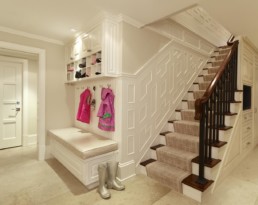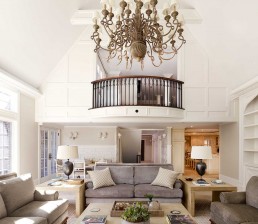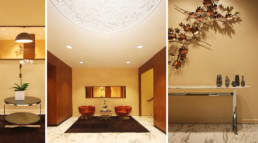The New Trends to Watch For in Residential Interior Design for Family Apartments
If you’ve ever wondered how New York City got to be known as “The City That Never Sleeps,” you’d have to venture back to the 1970’s and listen to John Kander and Fred Ebb’s song “New York, New York.” Ironically, however, parents in the modern day are bringing a new meaning to the moniker—as people are choosing to raise their kids in the city.
Couples are moving into large apartments (or, combining apartments) and even restoring full brownstones to accommodate their growing families. These urban parents want the newest trends in residential interior design but they also want homes that are child-friendly.

As anyone who has ever worked with small kids may know, “trendy” and “child-proof” are two realities that rarely (if ever) mesh together. But just because you have kids it doesn’t mean you can’t update your home with an eye to the newest trends in interior design.
So, if the above scenario speaks to you and…
- you want to reduce the wear and tear on your furniture and flooring
- you want to entertain guests in your home without it looking like a medieval war zone
- you want to incorporate the newest trends in interior design and create a safe place for your kids, too
. . . then an interior designer who is familiar with creating high-traffic environments that withstand the brutal forces of human nature is a great choice. Over the years I’ve discovered that what I’ve learned as a lobby interior designer enables me to create family oases in the city that stand the test of time.
To mesh the newest trends in residential interior design and with the needs of a growing family, I focus on the three most important elements of the interior design process:
1. Choosing The Right Fabrics
When designing residential spaces I look for colors and patterns that will maintain their allure while also being able to hide soil. For you parents out there, this is a huge stress reliever because your furniture will require cleaning less often (and you won’t be embarrassed when you have guests!).

If your apartment is really bright, I choose fabrics that resist fading (fading is a big problem in lobbies). But, if your family can’t give up that favorite couch, then we can add a film to the windows to reduce the intensity of direct sunlight.
One of my other tried and true tricks is to use fabrics manufactured with non-toxic surface protection that makes them easy to clean. So, if your child (or, your partner) has a knack for plastering peanut butter on the couch, these fabrics are phenomenal.
2. The Latest in Traffic Patterns and Flooring
Furniture is always about placement, placement, placement. For example, I wouldn’t locate a valuable lamp right next to the kitchen. I’m sure you would hate to see it knocked over by a running child before dinnertime!

And the process I use to analyze traffic patterns in a child-friendly interior design plan is nearly identical to what I use for lobby interior design projects. If your living space sometimes feels like Grand Central, then listen up:
Your high traffic areas should have hard flooring because it can be easily cleaned. Your low traffic areas are where you will use your carpet or rugs. Keeping this in mind makes floor cleanup a breeze and helps preserve your valuable carpet and rugs.
One piece of advice to bear in mind about carpet and rugs is that natural materials are often easier to maintain that their synthetic counterparts (i.e. wool vs. nylon). One of the newest trends in residential interior design is custom Rug installations. These are available from local Rug manufacturers I have built relationships with over the years for lobby project. I’ve ordered custom rugs from them for various apartment interior designs – all which are durable and easy to clean.
3. Types of Wall Coverings
For adult apartments, paper and fabric wall coverings are spectacular, but they’re not easy to keep clean. A design trick I learned as a lobby interior designer is to select wall coverings that look just like fabric, but are made of vinyl, instead. These are remarkably easy to clean (sticky hands, we’re looking at you!), don’t require a special application of surface protection (whereas expensive wall coverings usually do), and because there are so many choices I can usually spot when a new interior design trend is starting.
But, if you’re not in love with the idea of vinyl, there are some lovely options in fabrics coated with a really powerful stain and spot resistant. They can be quite costly but are worth it if your budget allows.
In closing, if you are raising kids in the “City That Never Sleeps”, focus on durability, easy maintenance, and easy wear. You deserve a home that withstands the onslaught of your kids and the other members of the traveling circus, while still incorporating some of the newest and interior design trends.
— Marilyn
Sygrove Interior Design Services
Sygrove Associates Design Group is an NYC interior design company. Our company’s founder Marilyn Sygrove is the lead interior designer on all projects. And she’s as tough as you are when it comes to quality, aesthetics, and coming in on time and on budget.
It all starts with a design consultation with Marilyn. She takes the time to thoroughly understand your design needs then personally directs all interior design, planning, and installation activities. Her work has been delighting clients, co-op and condo boards, and homeowners for over 30 years.
You can reach Marilyn by email at hello@sygrove.com or call her directly at 212.757.0631.
Share This Article
6 Mistakes People Make When They Hire A Lobby Interior Designer

I have been a lobby interior designer for over thirty years. By any standard, I am likely the most experienced (or one of the most experienced) interior designer of condo and coop building lobbies in the New York City area. I’m aware of every single possible mistake that can be made when a building sets out to hire an interior designer for their lobby.
Simply put, I’ve seen it all. Most mistakes that people make when they hire a lobby interior designer are due to not getting enough of the right information right off the bat. These kinds of mistakes can result in stress for residents during construction, materials that don’t hold up to wear, and traffic patterns that make getting through a lobby more like running an obstacle course.
So, if your building is getting ready to hire a lobby interior designer, here’s a list I created that will help save you some of the headaches, heartache, and torment of your lobby rehab.
Avoid These 6 Common Mistakes When Hiring an Interior Lobby Designer.
Mistake #1: Hiring an interior designer who’s never designed a lobby before.
This seems like a no-brainer, right? Well, in fact, this simple oversight is more common than you would imagine. If you hire a designer who is inexperienced with lobby design, you are actually hiring a residential designer.
Notwithstanding this person may be very experienced in home design, when you hire a bonafide lobby interior designer, you get someone deeply conversant with ADA compliance and regulations, fabrics that can withstand day-to-day foot traffic, local rules that affect everything from where and when a truck can unload to how to manage the varying tastes and opinions of residents.
Without that knowledge and expertise, your lobby interior design project can become a long nightmare.
What to ask before you hire: “How many lobbies have you designed?” Then, ask to see them. You be the judge!
Mistake #2: Hiring an interior designer who’s overwhelmed with other projects.
It’s can be difficult to resist a designer who arrives with a dazzling portfolio, but . . . you don’t want to hire someone who has ten concurrent projects in rotation at one time and uses freelancers to keep things afloat. This could make your lobby project drag on and on
What to ask before you hire: “Do you have a permanent staff? Do you have an office?” “Do you have client testimonials we can see? References?” Or, even better yet, “Will you take us to see your finished projects?” Give them the opportunity to showcase their smarts. (Word of advice, be cautious of interior designers who work from home.)
Mistake #3: Hiring an interior designer who’s unfamiliar with the logistics of working in your local area.
This can be like hiring someone from the Tanami Desert to design a rain garden in downtown Pittsburgh! For example, New York City is where I mostly work, is very complex—with a wide variety of ordinances and regulations to navigate. Your building could get into costly trouble if your lobby interior designer doesn’t adhere to the rules. The designer with a gorgeous portfolio of lobbies in another city may not be the best choice.
What to ask before you hire: This one’s fairly simple—”Where have you completed the majority of your projects?” If a few of them happen to be local, let them take you for a personal tour of these spaces. Then do more research, such as contact coop boards or building management companies to find out how people actually felt about the process and the finished space. Due diligence here is a must.
Mistake #4: Hiring someone who’s just getting started as a lobby interior designer.
Now, if you’re trying to give your great-grandson a jumpstart on his new career – then by all means welcome the idea. Just make sure to hire a veteran to provide proper mentorship. For the other 99.87% of cases, a budding new designer simply doesn’t possess the level of experience with residents, coop boards, building management, and staff to pull it off. And, be advised, there are a lot of personalities to deal with as each party can play a role in the decision-making.
What to ask before you hire: “How long have you been in business? “How many projects have you completed since you started?” “Can we interview a board member from a previous project?” Let them show you their track record.
Mistake #5: Hiring an interior designer who doesn’t charge enough (what??)
Listen, I know this sounds crazy, but if the price is too good to be true it probably is. Dig deep into the proposal and you’ll likely find some big holes—which is the perfect storm for your project going way over budget. Save yourself some time (and vacation money) – save the cheap prices for Dollar General.
What to ask before you hire: Make sure to get an itemized proposal and a written assurance that any work that is outside your budget and scope will only be executed upon your written approval.
Mistake #6: Hiring an interior designer who doesn’t understand the difference between rehab vs. new construction.
You see, new construction is easy—because these buildings are unoccupied and you don’t have to account for people roaming in and out. But in an occupied building, once the laundry room, elevator and mail room are installed, access to each of these spaces becomes a huge issue—as the residents’ lives cannot be overly disrupted. When they are (and they will be), it wreaks havoc for everyone.
What to ask before you hire: “What lobby renovations vs. new builds have you completed? Do you tend to focus on one over the other?” Once you have a good feel for the level of experience, go see for yourself.
If you are getting ready to hire a lobby interior designer, follow my advice and you can avoid many costly and time-consuming (not to mention stressful) mistakes.
Just a note:
I’ve developed processes and protocols that enable my firm to deliver exceptional results in lobby interior design. We have an intimate understanding of the nuances of construction in the New York City area including local regulations, compliance, and permitting. We are highly experienced in navigating and managing resident/management expectations. We are adept at keeping our projects on time and on budget. And, last but not least, we create extraordinarily beautiful spaces that are functional, comfortable, and stand the test of time.
Peruse our gallery of finished lobby interior design projects here.
Sygrove Interior Design Services
Sygrove Associates Design Group is an NYC interior design company. Our company’s founder Marilyn Sygrove is the lead interior designer on all projects. And she’s as tough as you are when it comes to quality, aesthetics, and coming in on time and on budget.
It all starts with a design consultation with Marilyn. She takes the time to thoroughly understand your design needs then personally directs all interior design, planning, and installation activities. Her work has been delighting clients, co-op and condo boards, and homeowners for over 30 years.
You can reach Marilyn by email at hello@sygrove.com or call her directly at 212.757.0631.

